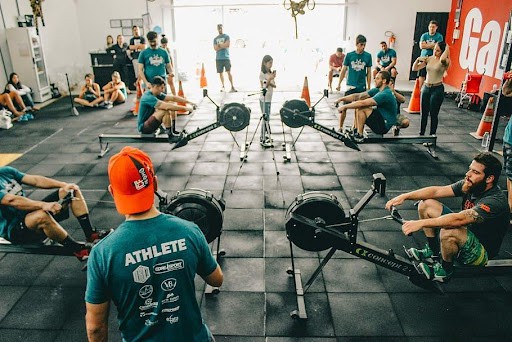Does the Rowing Machine Burn Arm Fat?
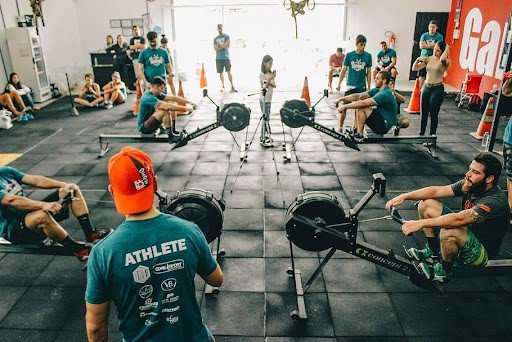
Yes, rowing will tone your arms because each stroke efficiently activates and trains the triceps, biceps, shoulders, and forearms.
Moreover, the rowing machine allows you to build endurance and strength and switch from cardio to a muscle-building workout.
So, whether you want to tone flabby arms or bulk up your arm muscles, the rowing machine can help.
An indoor rowing workout also outperforms treadmill and stationary bike workouts because it targets the upper body more effectively.
How to Use a Rowing Machine to Tone Arms
Rowing regularly will help burn calories and improve your overall health as an aerobic and anaerobic exercise. Rowing for longer at lower difficulty levels will help you lose weight and get rid of flabby arms.
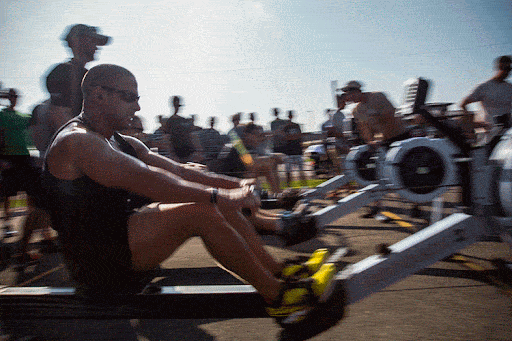
And, if you want to build bigger arm muscles, you can switch to slower and harder rowing workouts at more difficult levels.
The rowing machine provides the advantage of combining cardio and strength training. This translates to more fat burned and muscle gained, addressing two fitness goals with a single machine.
According to research, it’s impossible to target fat from a specific area of your body, so spot reduction of fat is a myth. Men, for example, have a harder time losing belly fat, whereas women have a harder time losing fat around their thighs.
But the good news is that most people do not regard arms as a stubborn area. Flabby arms are usually a sign of either bad dieting, lack of exercise, or aging. You’ll lose the extra pounds and develop more defined arm muscles as you eat healthier and row regularly.
How Long Should I Work Out on a Rowing Machine to Get Bigger Arms?
A 20-minute high-intensity rowing workout 4 times per week can help you gain decent arm muscle mass. Taking care of your diet and getting enough rest are equally important for your gains as well.
During a 30-minute indoor rowing workout, a 155-pound person will burn 260 kcal calories. However, your age, gender, fitness level, muscle mass, and body fat percentage all influence the number of calories burned on the rowing machine.
Beginners should gradually increase their exercise time to avoid overtraining or injury. The rowing machine engages your triceps, biceps, and shoulders, efficiently and you’ll feel the sores in these muscles in the following days.
Which Phase of the Rowing Stroke Works Arms?
Rowing is a full-body workout that trains up to 86% of your skeletal muscle. A study examining the rowing motion found that the legs contribute 50% of the power, the trunk 49%, and the limbs 19% of the power during a rowing stroke.
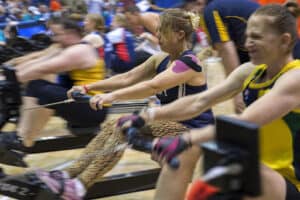
Let’s see which parts of the rowing stroke activate the arm muscles.
1. Catch
The catch is the first phase of the rowing stroke. Your body is near the front of the machine with your knee close to your chest.
Your triceps are engaged here because you are extending them while holding the handlebar.
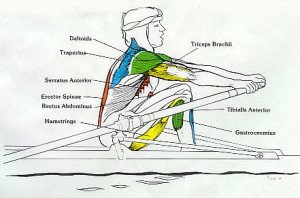
The back muscles are also activated, especially the lats (latissimus dorsi). They help maintain a straight posture and assist your arms while the traps control the shoulder blades.
2. Drive
The drive is the second phase of the rowing stroke when you use your leg power to push yourself away from the flywheel. As you extend your legs, your hips and core swing the body in the upright position.
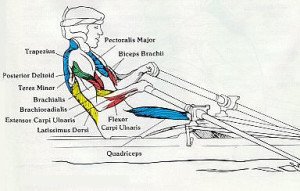
Your triceps, which were engaged during the catch, transfer the power to your biceps and shoulders during this phase.
Your shoulders, biceps, and lats use the produced power to pull the handle toward your chest. Here we have a strong engagement of the biceps, which pull the handlebar toward your ribcage.
3. Finish
During the finish, the body hinges slightly backward, the legs are fully extended, and the handle is brought to your ribcage by internally rotating your shoulders.
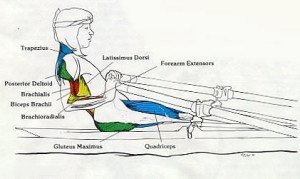
Besides the core muscles that help the hips hinge and keep the body stabilized, the bicep power is also very necessary here. Biceps help the shoulders rotate internally, but they also assist the back muscles in maintaining a straight posture.
For beginner rowers, the internal rotation might be particularly challenging because the rowing stroke is more of a skill that you develop over time and with practice. In the video below, Dark Horse Rowing explains how to optimally use your arms while rowing.
4. Recovery
The recovery is all about safely and steadily going back to the starting phase, the catch. During the previous phase, the handlebar was brought close to the ribcage. Now, we move the arms away from the body by extending them while the hips and torso swing backward.
Extending your arms slowly will fire up your muscles, especially the triceps, biceps, and shoulders. Make sure to keep your elbows and arms parallel to the ground and fully extended them. As you approach the front of the machine, hinge forward and use your hamstrings to bend your knees.
Throughout the rowing stroke, you’ve efficiently trained all the major muscle groups and kept your arm muscles, triceps, biceps, and shoulders engaged at all times.
A bonus tip* for greater engagement of the arm muscles: Make sure to steadily but quickly bring the handle to your ribcage during the finish, and then, slowly extend your arms during the recovery. This is called eccentric training and helps achieve greater muscle hypertrophy.
3 Rowing Machine Workouts to Tone Arms
Here are some rowing machine workouts to help you tone flabby arms.
Strength training with sets and reps
Set the row machine on high resistance levels (5-10) and perform shorter sets. To achieve muscle hypertrophy, perform 5-12 reps and repeat for up to 10 sets. You’ll gain more muscle if those final reps are harder for you to complete.
Cardio workout
If you are already comfortable with the rowing machine, you can row steadily for 15 to 30 minutes or even longer. This will improve your endurance, burn more calories, and yield great cardiovascular health benefits.
HIIT rowing workout
A modified HIIT workout is also a great way to get a cardio and strength workout in less time. With HIIT, you push yourself as hard as you can for a period of time, then reduce the resistance by 50% for twice the amount of time.
Rowing fitness programs like OrangeTheory are even incorporating some of these workouts into their routines!
For example:
| Level | Row/Rest Time |
|---|---|
| Level 6 | Row for one minute |
| Level 3 | Row for two minutes |
| Level 7 | Row for one minute |
| Level 3 | Row for two minutes |
| Level 8 | Row for one minute |
| Level 3 | Row for two minutes |
| Rest | 3 minutes |
| Repeat | 3-6 times |
Takeaway: Does Rowing Help with Flappy Arms?
The row machine will tone your arms and help you gain as much muscle and strength as you want. It outperforms other machines like a treadmill, stationary bike, or even an elliptical machine.
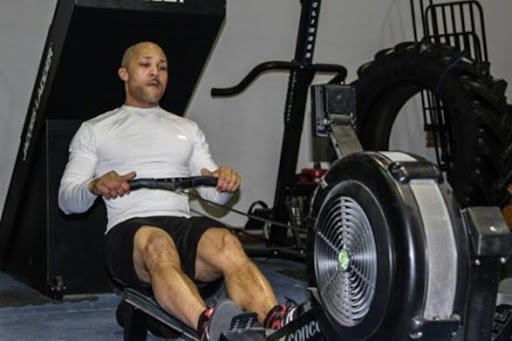
Outdoor or indoor rowing provides an excellent cardiovascular workout that activates all major muscle groups.
One of the best gym equipment for arm flab, the rowing machine builds muscle in your upper and lower body and efficiently targets your biceps, triceps, shoulders, and forearms.
If you row regularly for 30 minutes 4 times per week you will surely build toned rowers’ arms.

Rowing Machine King Founder and Author.

 АРХИВ
АРХИВ БОКС И ЕДИНОБОРСТВА
БОКС И ЕДИНОБОРСТВА Игровые виды спорта
Игровые виды спорта КАРДИОТРЕНАЖЕРЫ
КАРДИОТРЕНАЖЕРЫ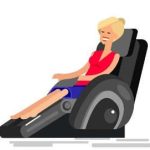 МАССАЖНОЕ ОБОРУДОВАНИЕ
МАССАЖНОЕ ОБОРУДОВАНИЕ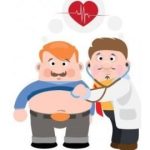 МЕДИЦИНА РЕАБИЛИТАЦИЯ
МЕДИЦИНА РЕАБИЛИТАЦИЯ СВОБОДНЫЕ ВЕСА
СВОБОДНЫЕ ВЕСА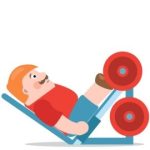 СИЛОВЫЕ ТРЕНАЖЕРЫ
СИЛОВЫЕ ТРЕНАЖЕРЫ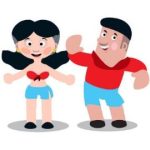 Соревновательное оборудование
Соревновательное оборудование СПОРТ ДЛЯ ДЕТЕЙ
СПОРТ ДЛЯ ДЕТЕЙ СПОРТИВНОЕ ПИТАНИЕ И АКСЕССУАРЫ
СПОРТИВНОЕ ПИТАНИЕ И АКСЕССУАРЫ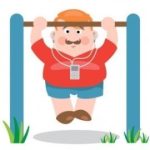 УЛИЧНЫЕ ТРЕНАЖЕРЫ
УЛИЧНЫЕ ТРЕНАЖЕРЫ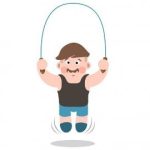 ФИТНЕС И АЭРОБИКА
ФИТНЕС И АЭРОБИКА